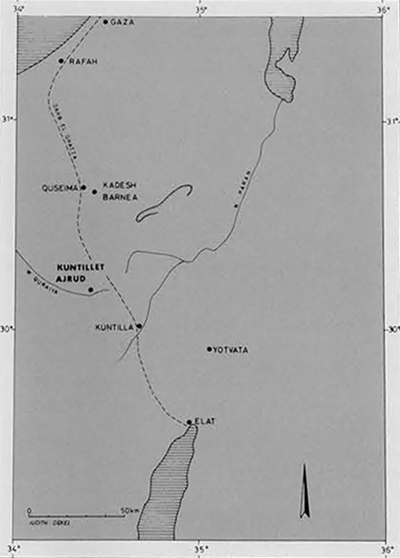
By which routes did the kings of Judah travel to Eilat and Ezion-Geber? And where was the southwestern border of the Judean kingdom in the Negev? Ruins of numerous Israelite forts have been discovered in the Negev, dating to the very beginning of the Judean Monarchy, but these are confined mainly to the Highlands in the region between Dimona and Qusaima, none further south than the Ramon Crater and Nahal Lotz. These forts were doubtlessly erected to guard the ancient routes of the Negev, thus pointing towards a route running from Beersheba to Kadesh-barnea. However, from the geographical point of view, this is not the shortest way by which to reach Eilat. Where then did the ancient road to Eilat pass?
Our quest for answers to these questions brought us to a site known as Kuntillet ‘Ajrud, which sits atop an isolated hill jutting out of the desert on the border of northern Sinai, about 50 km. south of Kadesh-barnea. The road known today as Darb el-Ghazza, leading from Gaza and Raphiah on the Mediterranean coast to Eilat, passes some 13 km. to the west, but it may be presumed that in ancient times its course ran near the foot of the hill, since one of the few water sources to be found in this arid region is located there. And, indeed, the Arabic name Kuntillet ‘Ajrud, meaning “the Solitary Hill of the Wells,” reflects the raison d’etre of the site—although today the cluster of wells at the foot of the hill are rather shallow and their waters not very palatable. In ancient times, however, this must have been a lush oasis. Upon examining ancient maps it may be noted that ‘Ajrud dominates not only a major north—south artery to Eilat from the coast but also straddled the crossroads of an important trail traversing Sinai through Wadi Quraiya and branching off towards the southern Sinai.
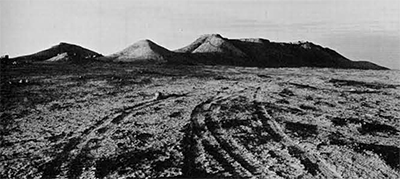
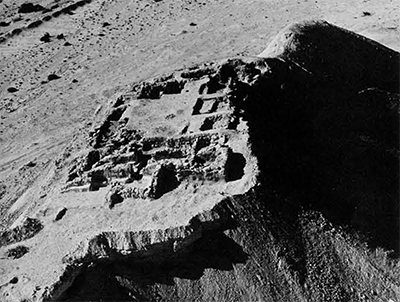
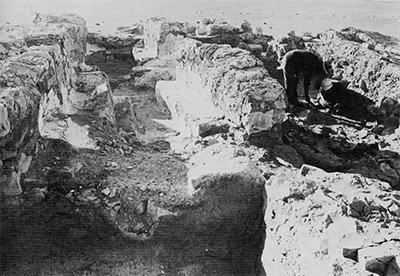
Explorers were already attracted to Kuntillet ‘Ajrud in the last century. Edward Palmer, famous for his survey of Mount Sinai, visited there in 1869 on his return from southern Sinai and even conducted a small-scale excavation. He suggested identifying it with the Roman Gypsaria appearing on the Peutinger map between Halutza and Eilat. This identification was accepted—and even adopted by some contemporary maps—until 1967 when the site was visited by Beno Rothenberg, who established from the pottery collected on the surface that it dates not to the Roman period but to the Judean Monarchy.
When we first visited Kuntillet `Ajrud in 1970 we found a rectangular pile of debris, concave towards its center, occupying most of the plateau at the north of the hill, its outlines resembling a typical fort of the Negev Highlands with its central courtyard surrounded by casemate walls. After three seasons of excavation, however, we discovered that this building is unique among the Israelite fortress-like sites found so far in the Negev, not only in its plan—which is lacking the casemates common to these forts —but also in the richness of its finds and the function it seems to have fulfilled.
The excavations were conducted in 19751976 by the author, assisted by the archaeological staff officers of the Israel Defense Forces (Sinai), A. Goren and B, Sass, and numerous kibbutz and student volunteers, who managed to withstand the extremities of the desert climate and the atmosphere of utter isolation that were doubtlessly also the lot of the ancient inhabitants of this windswept hilltop.
We discovered that the site consists of two buildings, the main one measuring about 15 x 25 meters, beautifully preserved, while the smaller building to its east was so badly eroded that little of its plan could be discerned; similar elements of decoration indicate, however, that both belong to the same period. Tentatively, we would date them both somewhere between the middle of the 9th and the middle of the 8th century B.C.
The walls of the main building, preserved in some places to a height of 1.5 meters, were built of the local chalk stone, reinforced with tamarisk branches—which grow even today in Wadi Quraiya at the foot of the hill—at a height of about 1.20 meters, and then plastered over with mud mixed with straw. This building technique recalls the description of the temple courtyard in Jerusalem in 1 Kings 7:12: “The great House had three courses of hewn stone round about and a course of cedar beams.” Of course, at Kuntillet `Ajrud the stones are not hewn and the beams are not cedar, but it is nevertheless remarkable that this wood has been preserved at all from such an early age.
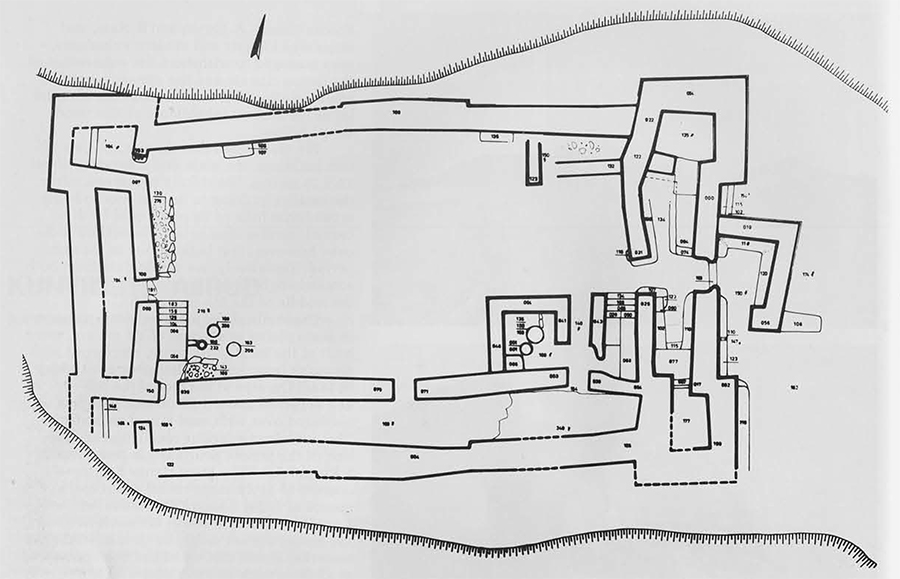
The entrance was through an open courtyard at the east leading into a gate room, which in turn led into a long narrow room flanked by two quasi-towers at the corners. Stone benches were built along all the walls of this entrance complex, but in the long, narrow room they took up so much of the space, leaving barely room to move between them, that we dubbed it the “Bench Room.” These benches were even built against what one would normally have expected to be the entrances to the corner towers, forming, as it were, the “window sills” of their openings. Floors, walls and benches were all covered with shiny white plaster.
A veritable treasure of inscribed material came from this room: two fragments of plaster which had fallen from the walls inscribed in Phoenician script, a third inscription still in situ on the door jamb and various other fragments of ink-inscribed plaster in the debris. It was in this Bench Room and its two corner rooms that most of the unique artifacts were found: two large pithoi bearing colored inscriptions and drawings, stone bowls with their donors’ names engraved on the rims, and fine pottery vessels such as juglets, lamps, flasks and bowls.
![Sherd showing a horse harnessed yo a chariot (?) The inscription reads: "May you be blessed [by the Lord]."](http://www.penn.museum/sites/expedition/files/1978/07/Sherd-showing-harnassed-horse.jpg)
3) Inscriptions in Ancient Hebrew on the rims of stone bowls: The most complete inscription of this type reads: l’bdyw bn ‘dnh brk h’ lyhw (Belonging to ‘Obadyau, son of ‘Adnah, may he be blessed by the Lord); on the others only the name was preserved, e.g. sm’yw bn ‘zr (Shem’ayau, son of ‘Ezer). Since one of these stone bowls weighed at least 200 kg., the donor—not to mention whoever had the task of hauling it to the site—must have had a sincere belief that the divine blessing requested would be bestowed upon him!
4) Inscriptions written in red or black ink on the plastered walls: Written in the Phoenician script, five such fragments were found; the only one in situ was so faded as to be practically illegible, while those found in the debris were too fragmented to be decipherable. Nevertheless, on one such fragment the name Jehovah appeared at least twice, and from such phrases as “may he bestow” or “the blessings of,” it is obvious that these inscriptions were of a dedicatory, beseeching or benedictory nature.
5) Inscriptions on pottery vessels accompanied by drawings: Written in red ink, these inscriptions also seem to be praises, requests or blessings. They are so faded however, that only sophisticated photographic techniques render them legible, and then only partially.
The same vessels are also densely covered with drawings. One scene shows the god Bes (Egyptian in origin) in typical stance and wearing a feathered headdress, standing in the center, another unidentified god at his right and a seated woman playing the lyre at the right. Elsewhere on the same pithos are a lion and other beasts, a tree of life on which two ibex are leaning, and a cow licking the tail of her suckling calf. This last scene is very similar to one depicted on the Nimrud ivories from the palace of Shalmaneser, while other details resemble those on the Samarian ivories. Indeed, all these motifs are part of the artistic repertoire of the Syrian-Phoenician world, and although crudely executed by local artists, testify to the contact between this isolated desert spot at ‘Ajrud and the cosmopolitan world far to its north.
The long narrow halls at the south and west of the courtyard were found densely packed with the bases of large storage jars and pithoi, thus leaving no doubt that these were the storerooms for the basic food supplies of the building; in fact, there was so little space between the jars that it is difficult to imagine how it was possible to pass between them. Near the entrance to the western storeroom was found a plaster fragment inscribed in red ink, and near the entrance to the southern storeroom a drawing in red, black and yellow, both poorly preserved. These fragments, together with the one found in situ in the Bench Room, naturally reminded us of the passage in Deut. 6:8: “And you shall write them on the doorposts of your house and on your gates.”
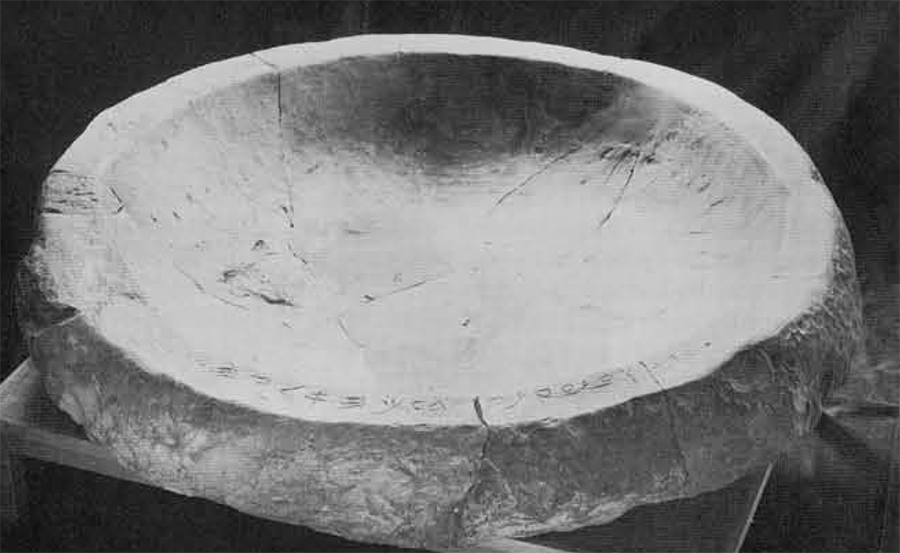
The entrances to the quasi-towers at the western corners of the building, unlike those of the corner rooms flanking the Bench Room, were directly from the courtyard. Both rooms seem to have storage bins against their back wall; in the better preserved room were found a collection of chalkstone plaques measuring about 50 x 60 cm., stone bowls and white-slipped juglets decorated with black and red stripes. These were obviously storerooms of a different type than the long halls, but their exact purpose—and particularly the function of the stone plaques—is unknown.
As a result of the arid climate, the site yielded a rare assortment of organic remains, including cloth, rope, baskets, woven mats, wooden vessels, pomegranates and lentils.
The most remarkable finds, however, were the inscribed objects of various types. These may be classified into five groups:
1)Ancient Hebrew letters incised before firing: Most of the pithoi bore a single letter on the shoulder, most commonly ale f, but a few were incised with yod or the combination qr; it is not clear whether these letters signified capacity, quantity, quality, destination or the purpose of the contents.
2)Ancient Hebrew names or epithets incised after firing: These were found on seven storage jars; three were private names such as ‘yr’ (Ira) and the rest were the word lsr’r- perhaps indicating that the goods within were consigned to the chief functionary (sr) of the city—the governor, commander or the like.
It is not only the location of the site, straddling an important crossroads to Eilat and southern Sinai, but finds such as seashells from the coast of both the Mediterranean and Red Seas that indicate the origin or destination of the traffic that passed through it; numerous objects of cedar and sycamore wood from the north, and Hinjuk Pistacia, the latter growing only in the mountains of southern Sinai, were also found in the excavations. Nevertheless, Kuntillet ‘Ajrud cannot be considered a usual wayside fortress like those in the Negev Highlands, nor even an ordinary caravanserai, although undoubtedly it furnished some amenities to the weary travellers who rested at the foot of the hill. But above and beyond any secular purpose, it undoubtedly had a religious function. The references to the Almighty in the wall inscriptions, the various deities depicted on the jars and the stone vessels brought to the site as offerings are all evidence of this role. However, neither can it be considered a temple, since it has none of the typical cult vessels (and no metal finds whatsoever) or the architectural style associated with such a building. In our opinion, it was a wayside shrine where the traveller sojourned, to rest both his body and his soul, to commune with the divine spirit and to pray to his own particular deity to bless his journey. The wall (an ancient Sheikh’s tomb) fulfills a similar function today. The focus of this shrine was the Bench Room where the offerings were presumably laid, the small rooms in the corners serving as a favissa after the benches were cleared away. The location of this shrine reflects an ancient Sinaitic tradition—perhaps connected with the sanctity of Mt. Hor, where the death of the priest Aaron occurred.
![Painted scene on one of the pithoi showing the god Bes in the center, another deity standing at his left and a seated woman playing the lyre at the right. The inscription reads: "X said to Y and to Z and to Yo'asah and...[May you be blessed] by the Lord who guards us and his asherah (cella, divine representation of the like)."](http://www.penn.museum/sites/expedition/files/1978/07/Painted-scene-pithoi-.jpg)
The Phoenician cultural influence so evident at ‘Ajrud also points towards the period shortly after the death of Jehoshaphat. Of his son Jehoram it is written (2 Kings 8:18) that “he walked in the way of the kings of Israel, as the house of Ahab had done, for the daughter of Ahab was his wife.” And of Ahaziah, his son, who ruled only one year, it is said (2 Kings 26-27) that “his mother’s name was Athaliah, she was the granddaughter of Omri, king of Israel.” At the same time that Jehu killed all the house of Ahab and annihilated the priests of Baal, Queen Athaliah was ruling over Judah and building a temple to Baal in Jerusalem. It is therefore tempting to point to her reign, a time when there were direct relations between the kingdom of Judah and the Phoenicians, perhaps even to the extent of granting them direct access to Eilat and the Red Sea, as the period during which our religious center at ‘Ajrud flourished.
Be that as it may, the importance of `Ajrud lies not only in its archaeological remains but in its contribution to the historical-geographical research of the Negev of Israel. The road to Eilat—at least at some stage around the end of the 9th century B.C.followed approximately the line of the Darb el-Ghazza of today. The border of the Judean kingdom was also most likely demarcated by this line, since it was the westernmost road over which the state seems to have exercised its authority at that time.
